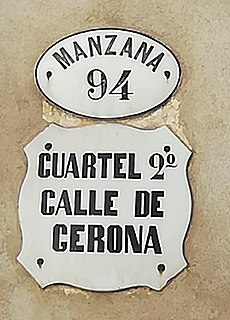Related Research Articles
The pound or pound-mass is a unit of mass used in British imperial and United States customary systems of measurement. Various definitions have been used; the most common today is the international avoirdupois pound, which is legally defined as exactly 0.45359237 kilograms, and which is divided into 16 avoirdupois ounces. The international standard symbol for the avoirdupois pound is lb; an alternative symbol is lbm, #, and ℔ or ″̶.

United States customary units form a system of measurement units commonly used in the United States and U.S. territories since being standardized and adopted in 1832. The United States customary system developed from English units which were in use in the British Empire before the U.S. became an independent country. The United Kingdom's system of measures was overhauled in 1824 to create the imperial system, which was officially adopted in 1826, changing the definitions of some of its units. Subsequently, while many U.S. units are essentially similar to their imperial counterparts, there are significant differences between the systems.
The ounce is the name of several different units of mass, weight or volume and is derived almost unchanged from the uncia, an Ancient Roman unit of measurement.
There are a number of Spanish units of measurement of length or area that are virtually obsolete due to metrication. They include the vara, the cordel, the league and the labour. The units of area used to express the area of land are still encountered in some transactions in land today.

Manzana, according to the Diccionario de la lengua española, the Spanish Royal Academy's Spanish language dictionary, in addition to its unrelated meaning as 'apple', is the
Chile adopted the metric system in 1848. Previously, the Spanish system of measures was used.
Peru adopted the metric system in 1862, replacing Spanish customary units.
The term "cuerda" refers to a unit of measurement in some Spanish-speaking regions, including Puerto Rico, Guatemala, Cuba, Spain, and Paraguay. In Puerto Rico, the term cuerda refers to the unit of area measurement. In Guatemala, cuerda is both a unit of length measurement as well as of area measurement. As a unit of area measurement, the Guatemalan cuerda can have various meanings. In Cuba, cuerda refers to a unit of volume measurement; in Spain and Paraguay, it refers to a unit of distance (length).
A number of different units of measurement were used in Argentina as its national system was derived from Spanish Castillian. The metric system was legally optional since 1863 and has been compulsory since 1887.
A number of different units of measurement were used in Brazil to measure quantities including length, area, volume, and mass as those units were derived from Portugal and had significant local variances.
A number of different units of measurement were used in Chile to measure quantities like length, mass, area, capacity, etc. From 1848, the metric system has been compulsory in Chile.
A variety of units of measurement were used in Colombia to measure quantities like length, mass and area. In Colombia, International Metric System has adopted since 1853, and has been compulsory since 1854.
A number of units of measurement were used in Costa Rica to measure measurements in length, mass, area, capacity, etc. In Costa Rica, metric system has been adopted since 1910, and has been compulsory since 1912, by a joint convention among Costa Rica, Guatemala, Honduras, Nicaragua and Salvador.
A number of units of measurement were used in Honduras for length, mass, volume etc. In Honduras, the metric system was adopted in 1910, and has been compulsory since 1912, under a joint convention between Costa Rica, Guatemala, Honduras, Nicaragua and El Salvador.
A number of units of measurement were used in Nicaragua to measure measurements in mass, area, volume, etc. In Nicaragua, the metric system was adopted in 1910, and has been compulsory since 1912, by a joint convention between Costa Rica, Guatemala, Honduras, Nicaragua and El Salvador.
A number of units of measurement were used in Cuba to measure quantities like mass, area, and capacity. In Cuba, Metric system has been compulsory since 1858.
A number of units of measurement were used in Mexico to measure length, mass, area, capacity, etc. The Metric system was optional from 1857, and has been compulsory since 1896.
A number of units of measurement were used in Paraguay to measure quantities including length, mass, area, capacity, etc. Metric system had been optional since 1890, and adopted since 1899 in Paraguay.
Several units of measurements are used in Puerto Rico. The units of measure in use in Puerto Rico are based on the United States customary units with two major exceptions: roadway distance signs are measured in kilometers and gasoline is sold in currency per liter.
A number of units of measurement were used in Venezuela to measure quantities like length, mass, etc. Metric system was optional in Venezuela since 1857, and has been compulsory since 1914.
References
- "Libro Almanaque Escuela Para Todos 2005" (in Spanish) (40). Mexico: Editorial Escuela Para Todos. ISSN 1409-1860.
{{cite journal}}: Cite journal requires|journal=(help)